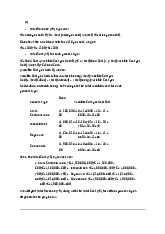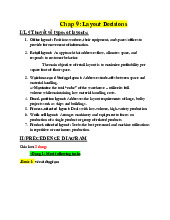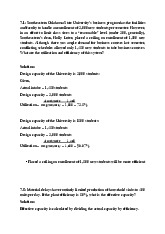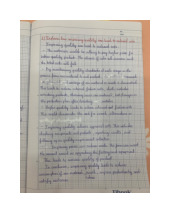



















Preview text:
lOMoAR cPSD| 58097008 Chap 1:
1. Marketing (good input => good teacher) + 2. Operation (product, di 昀昀 erentiation, cost) => ảnh
hưởng tới 10 quyết định + 3. Finance Let x denoted quantity Y denoted total cost
TC formula: TC = FC + VC.Q Y = b +a.x
Project A: y = 50k +12x; x=0 => y=… Project B:…
Interaction point between A and B X, y Vẽ biểu đồ
Break-even point in unit for A is: BEPa = (昀椀 xed cost)/(revenue generate by each unit – variable cost) = x
Break-even point in unit for B is: BEPb = (昀椀 xed cost)/(revenue generate by each unit – variable cost) = x Dễ hiểu hơn:
At break-even point, total cost = total revenue =>
For A: 50000 + 12.x = 20.x (cost = revenue)
For B: 70000 + 10.x = 20.x
Khi internal resource mình bị đứt thì mình bắt buộc phải outsource FISHBONE CHART lOMoAR cPSD| 58097008
Cause-and-E 昀昀 ect Diagrams Another tool for identifying quality issues and inspection points is the
cause-and-e 昀昀 ect diagram, also known as an Ishikawa diagram or a 昀椀 shbone chart. Figure 6.7
illustrates a chart (note the shape resembling the bones of a 昀椀 sh) for a basketball quality control
problem—missed freethrows. Each “bone” represents a possible source of error.
The operations manager starts with four categories: material, machinery/equipment, manpower, and
methods. These four Ms are the “causes.” They provide a good checklist for initial analysis. Individual
causes associated with each category are tied in as separate bones along that branch, often through a
brainstorming process. For example, the method branch in Figure 6.7 has problems caused by hand
position, follow-through, aiming point, bent knees, and balance. When a fsh-bone chart is systematically
developed, possible quality problems and inspection points are highlighted. lOMoAR cPSD| 58097008 lOMoAR cPSD| 58097008 lOMoAR cPSD| 58097008
Achieving Competitive Advantage Through Operations lOMoAR cPSD| 58097008
Competing on Di 昀昀 erentiation
Di 昀昀 erentiation is concerned with providing uniqueness. A 昀椀 rm’s opportunities for creating
uniqueness are not located within a particular function or activity but can arise in virtually everything the
昀椀 rm does. Moreover, because most products include some service, and most services include some
product, the opportunities for creating this uniqueness are limited only by imagination. Indeed, di 昀昀
erentiation should be thought of as going beyond both physical characteristics and service attributes to
encompass everything about the product or service that in 昀氀 uences the value that the customers
derive from it. Therefore, e 昀昀 ective operations managers assist in de 昀椀 ning everything about a
product or service that will in 昀氀 uence the potential value to the customer. This may be the convenience
of a broad product line, product features, or a service related to the product. Such services can manifest
themselves through convenience (location of distribution centers, stores, or branches), training, product
delivery, and installation, or repair and maintenance services.
In the service sector, one option for extending product di 昀昀 erentiation is through experience. Di 昀昀
erentiation by experience in services is a manifestation of the growing “experience economy.” The idea of
experience di 昀昀 erentiation is to engage the customer—to use people’s 昀椀 ve senses so they become
immersed, or even an active participant, in the product. Disney does this with the Magic Kingdom. People
no longer just go on a ride; they are immersed in the Magic Kingdom—surrounded by dynamic visual and
sound experiences that complement the physical ride. Some rides further engage the customer with
changes in air 昀氀 ow and smell, as well as having them steer the ride or shoot at targets or villains. Competing on Cost
For example: Product decision: cost leadership: honda đánh bại thị trường
TQ dù giá xe TQ rẻ hơn nhiều. Rẻ nhưng bộc lộ rõ chất lượng kém, đi tầm 3-4 năm là nát. => Honda ra
đời dòng wave với giá 12-14 triệu => Giá xứng đáng => Tìm mission và strategy của honda lOMoAR cPSD| 58097008 lOMoAR cPSD| 58097008 lOMoAR cPSD| 58097008 lOMoAR cPSD| 58097008 lOMoAR cPSD| 58097008 lOMoAR cPSD| 58097008 lOMoAR cPSD| 58097008 lOMoAR cPSD| 58097008 lOMoAR cPSD| 58097008 lOMoAR cPSD| 58097008 lOMoAR cPSD| 58097008 lOMoAR cPSD| 58097008 Câu hỏi: Chap 1:
2. Identify four people who have contributed to the theory and techniques of operations management
=> They include Eli Whitney, Frederick Winslow Taylor, Henry Ford and Charles Sorensen. They all
contributed to the theory and the techniques of operations and management.
4. Figure 1.1 outlines the operations, 昀 椀 nance/accounting, and marketing functions of three
organizations. Prepare a chart similar to Figure 1.1 outlining the same functions for one of the
following: a. a newspaper b. a drugstore c. a college library d. a summer camp e. a small costume- jewelry factory lOMoAR cPSD| 58097008
5. Answer Question 4 for some other organization, perhaps an organization where you have worked.
6. What are the three basic functions of a 昀椀 rm?
=> Finance + marketing + operation management Chap 2:
2.List six reasons to internationalize operations.
=> (1) Reduce costs (labor, taxes, tari 昀昀 s, etc.); (2) Improve the supply chain; (3) Provide better
goods and services; (4) Understand markets; (5) Learn to improve operations; (6) Attract and retain global talent
4. De 昀椀 ne mission
Mission is a task which requires action and it focuses on what is needed to be done today. It is what drives
an organization or a student towards their goal. It also clari 昀椀 es how you gonna do what you need to
do . Most organizations have their own missions which drives them lOMoAR cPSD| 58097008
(SÁCH) Economic success, indeed survival, is the result of identifying missions to satisfy a customer’s needs
and wants. We de 昀椀 ne the organization’s mission as its purpose—what it will contribute to society.
Mission statements provide boundaries and focus for organizations and the concept around which the 昀
椀 rm can rally. The mission states the rationale for the organization’s existence. Developing a good
strategy is di 昀케 cult, but it is much easier if the mission has been well-de 昀椀 ned. Figure 2.2 provides
examples of mission statements.
Once an organization’s mission has been decided, each functional area within the 昀椀 rm determines its
supporting mission. By functional area we mean the major disciplines required by the 昀椀 rm, such as
marketing, 昀椀 nance/accounting, and production/operations. Missions for each function are developed
to support the 昀椀 rm’s overall mission. Then within that function, lower-level supporting missions are
established for the OM functions. Figure 2.3 provides such a hierarchy of sample missions.
5. De 昀椀 ne strategy
Strategy is a process that helps in setting and achieving goals. It is the plan by which one aims to achieve
a goal and de 昀椀 ne what should be done to achieve it. To put it simply, the strategy helps in determining
how one will go about achieving their objectives
(SÁCH) With the mission established, strategy and its implementation can begin. Strategy is an
organization’s action plan to achieve the mission. Each functional area has a strategy for achieving its
mission and for helping the organization reach the overall mission. These strategies exploit opportunities
and strengths, neutralize threats, and avoid weaknesses. In the following sections, we will describe how
strategies are developed and implemented.
Firms achieve missions in three conceptual ways: (1) di 昀昀 erentiation, (2) cost leadership, and (3)
response. This means operations managers are called on to deliver goods and services that are (1) better,
or at least di 昀昀 erent, (2) cheaper, and (3) more responsive. Operations managers translate these
strategic concepts into tangible tasks to be accomplished. Any one or combination of these three strategic
concepts can generate a system that has a unique advantage over competitors.
6.Describe how an organization’s mission and strategy have di 昀昀 erent purposes
=> In the organizations perspective, the mission is the term de 昀椀 ned the ways to achieve the
vision. Strategies are the ways or series of ways of utilizing the mission to achieve the vision. The
fundamental plan of the strategic planning of the organization to align the mission with the vision. A
mission is the purpose of the company (what), as well a strategy is known as our roadmap (how’s).
The mission is the de 昀椀 nition of the key attributes of the company and board goals in which an
organization is formed, as well as the strategy is the accomplishment of resource allocation, decision
making, short, and long term goals
=> An organization's mission and strategy have di 昀昀 erent purposes. The mission of an organization
is a statement that de 昀椀 nes its purpose and reason for existence. It outlines what the organization
wants to achieve and its core values. On the other hand, an organization's strategy is a plan or set of
actions that it takes to achieve its mission. It outlines how the organization will allocate its resources,
make decisions, and pursue its goals.



